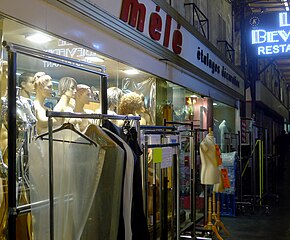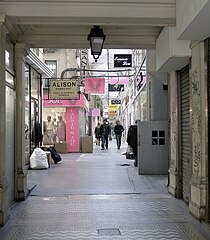Passage du Caire
| Passage du Caire | |
|---|---|
| location | |
| Arrondissement | 2. |
| quarter | Bonne-Nouvelle |
| morphology | |
| length | 360 m |
| width | 2.6 |
| history | |
| Emergence | 1798 |
| Original names | Passage de la Foire du Caire |
| Coding | |
| Paris | 1422 |
The Passage du Caire , named after the city of Cairo , is a covered shopping arcade with a glass roof from the end of the 18th century in the 2nd arrondissement in Paris . The Passage du Caire is a monument worthy of protection ( monument historique ).
Situation and access
Passage du Caire is located between 2, place du Caire and 33, rue d'Alexandrie, in a mixed residential and business district near the Grands Boulevards . Other entrances are at 237–239, rue Saint-Denis and 14, rue du Caire. Sentier is the nearest metro station on line 3 that crosses Paris from east to west. The proximity to the large boulevards favored the construction of the passage.
The most important shops are the wholesalers in ready-to-wear fashion. The passage is pretty dilapidated and has lost much of its charm, so that today it only houses fabric shops without an old character and is visited by clothing suppliers during the week. Strollers rarely come into this passage without attraction.
Other passages are nearby: Passage du Prado , Passage Bourg-l'Abbé and Passage du Grand-Cerf .
“Retour d'Égypte” facade on the Place du Caire .
Place du Caire entrance .
Entrance Rue Saint-Denis .
At 370 m, the Passage du Caire is the longest in Paris. In contrast, it is one of the narrowest with an average width of 2.70 m. The passage is open Monday through Friday between 7 a.m. and 6.30 p.m.
history
The name Passage du Caire ( German Passage Kairo ) was given to it in memory of the victorious invasion of the French troops in Cairo on July 23, 1798. It was opened at the end of 1798 and is one of the oldest shopping arcades in Paris. The Filles-Dieu monastery was previously located on the site of the passage, the square and the adjacent houses . The longest passage in Paris, 370 meters long, has three galleries: Galerie Sainte-Foy (Saint Fides), Galerie Saint Denis (Saint Dionysius) and Galerie du Caire. There is a rotunda at the intersection of the two main galleries or corridors . The quarter was built by Napoleon after the Egyptian campaign in 1798 and its architectural decor is characterized by Egyptian influences. The entrance from the Place du Caire is adorned with large sphinx heads and reliefs .
Originally, the passage was used by printers and lithographers . Today it is owned by companies in the textile industry, manufacturers of ready-made clothing and their suppliers. The Passage du Carie is located in the Sentier district , which is traditionally the home of the clothing industry with all its branches.
Literary mention
In his cycle Les Enquêtes de Nestor Burma et les Nouveaux Mystères de Paris , more precisely in the thriller about the 2nd arrondissement ( Des kilomètres de linceuls ), Léo Malet recalls the passage in Cairo : his hero Nestor enters Burma after a missed appointment A café that is open all night on Kairoer Platz, down the aisle around three in the morning and stumbles over Esther Lévyberg's body.
Current condition
None of the many shops still has the old decor and the window fronts have also been renewed. The glass roof is partially leaking and cables run through the aisles. The aisles, which are only 2.70 m wide on average, are full of shop accessories on weekdays and are livened up by the coming and going of suppliers and forwarding agents.
literature
- Jean-Claude Delorme, Anne-Marie Dubois: Passages couverts parisiens . Parigrams, Paris 2002 (1st edition Paris 1996), ISBN 2-84096-264-0 .
- Bertrand Lemoine : Les passages couvertes en France . Délégation à l'Action Artistique de la Ville de Paris, Paris 1990, ISBN 2-905118-21-0 .
Web links
- Passage du Caire Description as Monument historique in the Base Mérimée of the French Ministry of Culture (French text)
Individual evidence
- ^ Léo Malet , Les Enquêtes de Nestor Burma et les Nouveaux Mystères de Paris , Paris, Robert Laffont, "Bouquins" collection, 1989 (4th edition), B. 1 ( ISBN 2221046064 ), p. 601
Coordinates: 48 ° 52 ′ 6 ″ N , 2 ° 20 ′ 59 ″ E







